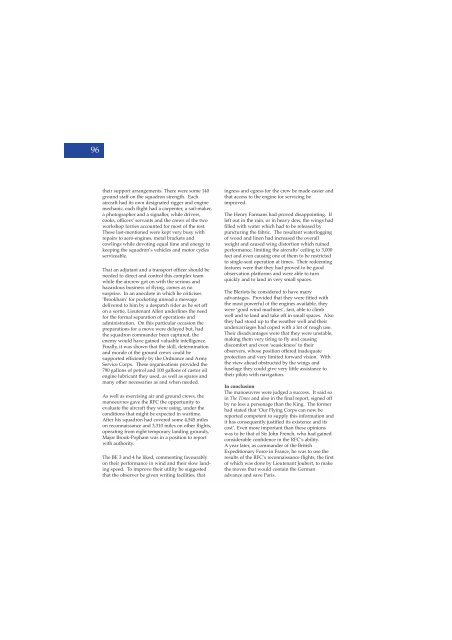Volume 6 No 4 - Royal Air Force Centre for Air Power Studies
Volume 6 No 4 - Royal Air Force Centre for Air Power Studies
Volume 6 No 4 - Royal Air Force Centre for Air Power Studies
You also want an ePaper? Increase the reach of your titles
YUMPU automatically turns print PDFs into web optimized ePapers that Google loves.
96<br />
their support arrangements. There were some 140<br />
ground staff on the squadron strength. Each<br />
aircraft had its own designated rigger and engine<br />
mechanic, each flight had a carpenter, a sail-maker,<br />
a photographer and a signaller, while drivers,<br />
cooks, officers’ servants and the crews of the two<br />
workshop lorries accounted <strong>for</strong> most of the rest.<br />
These last-mentioned were kept very busy with<br />
repairs to aero-engines, metal brackets and<br />
cowlings while devoting equal time and energy to<br />
keeping the squadron’s vehicles and motor cycles<br />
serviceable.<br />
That an adjutant and a transport officer should be<br />
needed to direct and control this complex team<br />
while the aircrew got on with the serious and<br />
hazardous business of flying, comes as no<br />
surprise. In an anecdote in which he criticises<br />
‘Brookham’ <strong>for</strong> pocketing unread a message<br />
delivered to him by a despatch rider as he set off<br />
on a sortie, Lieutenant Allen underlines the need<br />
<strong>for</strong> the <strong>for</strong>mal separation of operations and<br />
administration. On this particular occasion the<br />
preparations <strong>for</strong> a move were delayed but, had<br />
the squadron commander been captured, the<br />
enemy would have gained valuable intelligence.<br />
Finally, it was shown that the skill, determination<br />
and morale of the ground crews could be<br />
supported efficiently by the Ordnance and Army<br />
Service Corps. These organisations provided the<br />
790 gallons of petrol and 100 gallons of castor oil<br />
engine lubricant they used, as well as spares and<br />
many other necessaries as and when needed.<br />
As well as exercising air and ground crews, the<br />
manoeuvres gave the RFC the opportunity to<br />
evaluate the aircraft they were using, under the<br />
conditions that might be expected in wartime.<br />
After his squadron had covered some 4,545 miles<br />
on reconnaissance and 3,310 miles on other flights,<br />
operating from eight temporary landing grounds,<br />
Major Brook-Popham was in a position to report<br />
with authority.<br />
The BE 3 and 4 he liked, commenting favourably<br />
on their per<strong>for</strong>mance in wind and their slow landing<br />
speed. To improve their utility he suggested<br />
that the observer be given writing facilities, that<br />
ingress and egress <strong>for</strong> the crew be made easier and<br />
that access to the engine <strong>for</strong> servicing be<br />
improved.<br />
The Henry Farmans had proved disappointing. If<br />
left out in the rain, or in heavy dew, the wings had<br />
filled with water which had to be released by<br />
puncturing the fabric. The resultant waterlogging<br />
of wood and linen had increased the overall<br />
weight and caused wing distortion which ruined<br />
per<strong>for</strong>mance, limiting the aircrafts’ ceiling to 3,000<br />
feet and even causing one of them to be restricted<br />
to single-seat operation at times. Their redeeming<br />
features were that they had proved to be good<br />
observation plat<strong>for</strong>ms and were able to turn<br />
quickly and to land in very small spaces.<br />
The Bleriots he considered to have many<br />
advantages. Provided that they were fitted with<br />
the most powerful of the engines available, they<br />
were ‘good wind machines’, fast, able to climb<br />
well and to land and take off in small spaces. Also<br />
they had stood up to the weather well and their<br />
undercarriages had coped with a lot of rough use.<br />
Their disadvantages were that they were unstable,<br />
making them very tiring to fly and causing<br />
discom<strong>for</strong>t and even ‘seasickness’ to their<br />
observers, whose position offered inadequate<br />
protection and very limited <strong>for</strong>ward vision. With<br />
the view ahead obstructed by the wings and<br />
fuselage they could give very little assistance to<br />
their pilots with navigation.<br />
In conclusion<br />
The manoeuvres were judged a success. It said so<br />
in The Times and also in the final report, signed off<br />
by no less a personage than the King. The <strong>for</strong>mer<br />
had stated that ‘Our Flying Corps can now be<br />
reported competent to supply this in<strong>for</strong>mation and<br />
it has consequently justified its existence and its<br />
cost’. Even more important than these opinions<br />
was to be that of Sir John French, who had gained<br />
considerable confidence in the RFC’s ability.<br />
A year later, as commander of the British<br />
Expeditionary <strong>Force</strong> in France, he was to use the<br />
results of the RFC’s reconnaissance flights, the first<br />
of which was done by Lieutenant Joubert, to make<br />
the moves that would contain the German<br />
advance and save Paris.
















